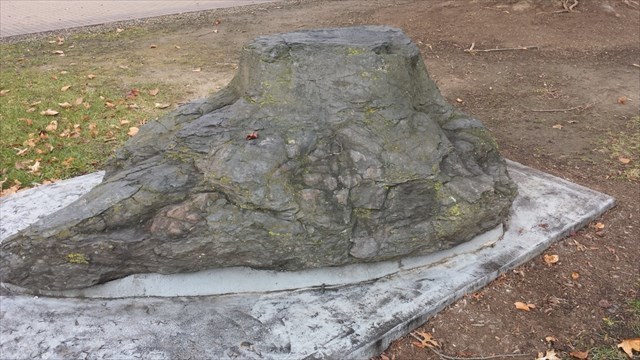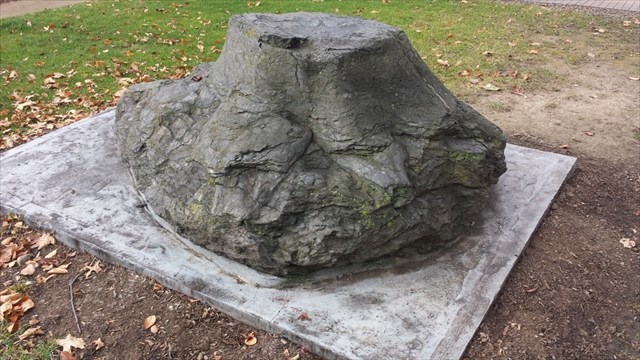There are three things you MUST pay attention to when doing this cache.ONE: If there are events going on in the area, DO NOT ATTEMPT. You must come back at another time. I will delete any and all logs that correspond with events. The Director of the library was very clear about this.TWO: There is street parking with meters. 25 cents is a lot cheaper than $25 so drop a quarter in the meter. THREE: You must send the answers to me through the messaging system NOT email. Groundspeak's unreliable email system does not send me these emails and I will delete your find if I don't get the answers. This is because I am tired of having to chase finders to get the answers.
In 1858 the Baltimore mine yielded up stumps estimated to be 300 million years old.
To claim this Earthcache you must answer the following questions to prove you visited the site. You must message me from through the geocaching.com site. The link is on my profile page. The email system through the geocaching site is not dependable so do not use it. Logs without answers will be deleted without warning three days after logging.
1.) Based on your observation, can you tell what type of coal this is?.
2.) What is the approximate age of the tree stump?
3.) Most of the stump is made of coal. On the street side there is an area of a complete different color. Describe the color and theorize what type of rock that it is.
4.) How large is the stump in diameter? (NOT including the base, just the tree itself.
5.) What causes wood to petrify?
6.) Can you count the rings of the tree and estimate it's age at time of death?
When mine superintendent Frederick Landmesser began his exploration of a caved-in area at the Baltimore Mine in the summer of 1858, he could not have been prepared for what he would find.
There. Among the rubble of rock, dirt, and coal between what are now Wilkes-Barre's East End and Parsons sections, lay the remains of a prehistoric forest – fossilized tree stumps, roots, limbs, and fragments of bark.
Study of the site, which lay as far as 300 feet underground, showed that the fossils had been contained in strata above the mine workings. The collapse crushed the pillars that had been left in the mine for support, dislodging the fossils and leaving them in a jumbled heap with the rest of the refuse.
The most striking of the artifacts were, “two large stumps as perfect as if just drawn from the Earth by a stump machine,” the Wilkes-Barre Record of the Time reported. The paper theorized that mining done closer to the surface had sheared off the upper parts of the prehistoric trees, leaving stumps and other fragments below.
The fossilized stumps, later estimated at 300 million years old, were not the first marvels to emerge from the Baltimore Mine, which had been organized in 1829 by Thomas Simington of Baltimore.
In 1853 an enormous block of anthracite coal, four or five feet by 29 feet, was hauled out of the mine. The 16,000 pound chunk was cut into four pieces, eventually ending up at the Crystal Palace exhibit in New York City, where it won a bronze medal.
But local newspaper files contain no mention of prehistoric fossils discovered earlier than the ancient forest at the Baltimore mine. In later decades, they would begin to turn up in other mines as well.
The Wilkes-Barre Record reported in 1930 that dinosaur footprints were discovered in the top Ross vein of the Raub colliery in Luzerne. Ten years later, representatives of the American Museum of Natural History took custody of some fossilized amphibian footprints from the East Boston Coal Co., also in Luzerne. Over the years, many small fossilized imprints of ferns have been found in rocks brought up from underground.
The sheer size and novelty of the tree stumps awed those who viewed them in the mid-19th century. The larger one, weighing an estimated 7,000 pounds and consisting of half coal and half slate, was eventually hauled downtown, where it was placed on a pedestal on the lawn in front of the South Franklin Street home of Pennsylvania Supreme Court Justice George W. Woodward. The home was diagonally across the street from the building that would later become the Osterhout Free Library.
Coal comes in three main types, or grades. First the swampy peat is squeezed and heated to form a brown, soft coal called lignite. In the process, the material releases hydrocarbons, which migrate away and eventually become petroleum. With more heat and pressure lignite releases more hydrocarbons and becomes the higher-grade bituminous coal. Bituminous coal is black, hard and usually dull to glossy in appearance. Still greater heat and pressure yields anthracite, the highest grade of coal. In the process, the coal releases methane or natural gas. Anthracite, a shiny, hard black stone, is nearly pure carbon and burns with great heat and little smoke. If coal is subjected to still more heat and pressure, it becomes a metamorphic rock as the macerals finally crystallize into a true mineral, graphite. This slippery mineral still burns, but it is much more useful as a lubricant, an ingredient in pencils and other roles. Still more valuable is the fate of deeply buried carbon, which at conditions found in the mantle is transformed into a new crystalline form: diamond. However, coal probably oxidizes long before it can get into the mantle, so only Superman could perform that trick.

There it would stay for many decades. In 1881 the Woodward house became the Feminine Institute, a school for girls. In 1926, when the school moved, the property was taken over by the Wyoming Historical and Geological Society.
When the building was torn down in 1976 the stump was moved across the street to the lawn between the library and the Westmoreland Club.
The Baltimore Mine lives on in Wyoming Valley lore mainly as the site of the second worst mining disaster in the community's history. On June 5th, 1919, 92 men were killed there when powder being carried in the mine cars blew up as a shift of miners was on its way into the mine for the day's work.
So, what causes wood to petrify? Since the petrified stump is made of coal, it is actually an organic material made up of carbon, so rather than the material being replaced by minerals like silica that you mention, it is actually the preserved remains of the plant itself. Coal differs from every other kind of rock in that it is made of organic carbon: the actual remains, not just mineralized fossils, of dead plants. Today the vast majority of dead plant matter is consumed by fire and decay, returning its carbon to the atmosphere as the gas carbon dioxide—it is oxidized. The carbon in coal, however, was preserved from oxidation and remains in a chemically reduced form, available for oxidation.
23 May 2017 NOTE. An interesting tidbit from cacher, Red Granite, a retired geology teacher: I don't feel the tree stump is petrified. Petrification involves the process where organic material is replaced with mineral material as in truly petrified wood. Your stump did not petrify but changed into coal. The cellulose in the trunk and roots of the tree could not rot away because oxygen was not present. Instead under heat and pressure it changed into almost pure carbon or coal. Most geologist do not consider coal a mineral nor a rock but a natural resource instead.

But in the huge fossil stump, the Baltimore also gave Wyoming Valley its greatest reminder of the timelessness of the Earth itself.
Permission granted for placement by Richard C. Miller,Executive Director,Osterhout Free Library
SOURCES
article from Times Leader by Tom Mooney circa 1990. reprinted with permission
geology.com/stories/13/petrified-wood/
http://geology.about.com/od/mineral_resources/a/aa_nutshellcoal.htm